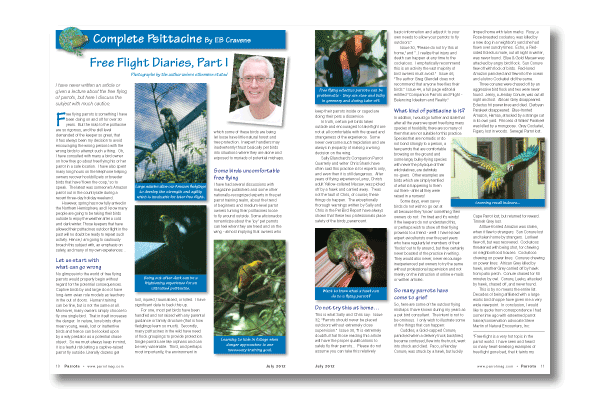
Free Flight Diaries, Part I
I have never written an article or given a lecture about the free flying of parrots, but here I discuss the subject with much caution.
Free flying parrots is something I have been doing on and off for over 30 years. But the risks to the psittacine are so rigorous, and the skill level demanded of the keeper so great, that it has always been my decision to avoid encouraging the wrong persons with the wrong birds to attempt such a thing. Oh, I have consulted with many a bird owner on how they go about free flying his or her parrot in a safe location. I have also spent many long hours on the telephone helping owners recover hookbill pets or breeder birds that have ‘flown the coop,’ so to speak. The latest was someone’s Amazon parrot out in the countryside during a recent three-day holiday weekend.
However, spring has now fully arrived in the Northern Hemisphere, and I know many people are going to be taking their birds outside to enjoy the weather after a cold and dark winter. Those keepers that have allowed their psittacines outdoor flight in the past will no doubt be ready to repeat such activity. Hence, I am going to cautiously broach this subject with, an emphasis on safety, and many of my own experiences…
Read more in the magazine…
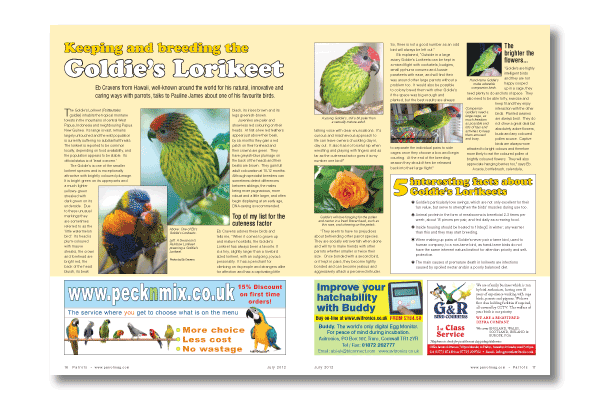
Eb Cravens from Hawaii, well-known around the world for his natural, innovative and caring ways with parrots, talks to Pauline James about one of his favourite birds.
The Goldie’s Lorikeet (Psitteuteles goldiei) inhabits the tropical montane forests in the mountains of central West Papua, Indonesia and neighbouring Papua New Guinea. Its range is vast, remains largely untouched and the wild population is currently suffering no substantial threats. The lorikeet is reported to be common locally, depending on food availability, and the population appears to be stable. Its official status is of ‘least concern.’
The Goldie’s is one of the smaller lorikeet species and is exceptionally attractive with brightly coloured plumage. It is bright green on its upperparts and a much lighter yellowy-green streaked with dark green on its underside. Due to these unusual markings they are sometimes referred to as the ‘little watermelon bird.’ Its head is plum-coloured with mauve streaks, the crown and forehead are bright red, the back of the head bluish, its beak black, its irises brown and its legs greenish-brown.
Read more in the magazine…
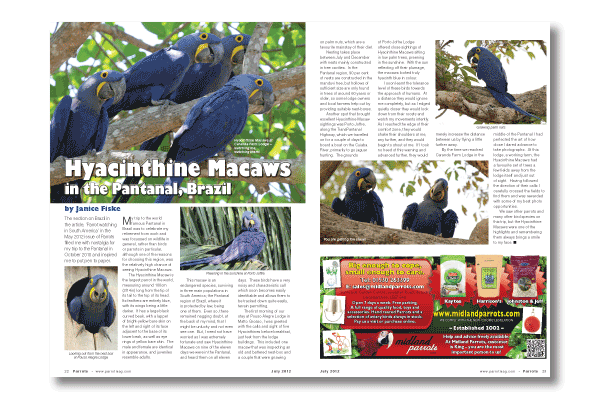
by Janice Fiske
The section on Brazil in the article, ‘Parrot watching in South America’ in the May 2012 issue of Parrots filled me with nostalgia for my trip to the Pantanal in October 2010 and inspired me to put pen to paper.
My trip to the world famous Pantanal in Brazil was to celebrate my retirement from work and was focussed on wildlife in general, rather than birds or parrots in particular, although one of the reasons for choosing this region, was the relatively high chance of seeing Hyacinthine Macaws.
The Hyacinthine Macaw is the largest parrot in the world, measuring around 100cm (3ft 4in) long from the tip of its tail to the top of its head. Its feathers are entirely blue, with its wings being a little darker. It has a large black curved beak, with a lappet of bright-yellow bare skin on the left and right of its face adjacent to the base of its lower beak, as well as eye rings of yellow bare skin. The male and female are identical in appearance, and juveniles resemble adults.
Read more in the magazine…
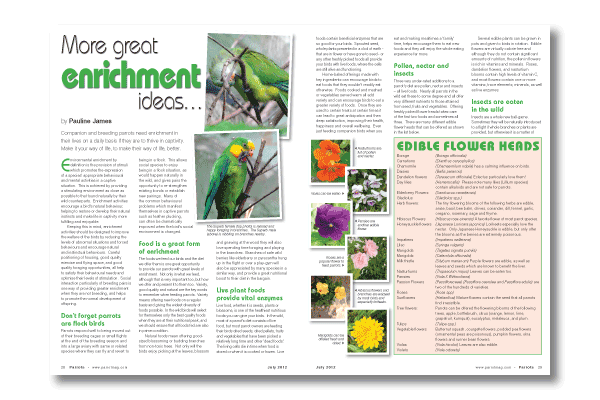
by Pauline James
Companion and breeding parrots need enrichment in their lives on a daily basis if they are to thrive in captivity. Make it your way of life, to make their way of life, better.
Environmental enrichment by definition is the provision of stimuli which promotes the expression of a species’ appropriate behavioural and mental activities in a captive situation. This is achieved by providing a stimulating environment as close as possible to that found naturally by their wild counterparts. Enrichment activities encourage a bird’s natural behaviour, helping to restore or develop their natural instincts and make life in captivity more fulfilling and enjoyable.
Keeping this in mind, enrichment activities should be designed to improve the welfare of the birds by reducing the levels of abnormal situations and forced behaviours and encourage natural and instinctual behaviours. Careful positioning of housing, good quality exercise and flying space, and good quality foraging opportunities, all help to satisfy their behavioural needs and optimise their levels of stimulation. Social interaction particularly of breeding pairs is one way of providing greater enrichment when they are not breeding, and helps to promote the normal development of offspring.
Read more in the magazine…
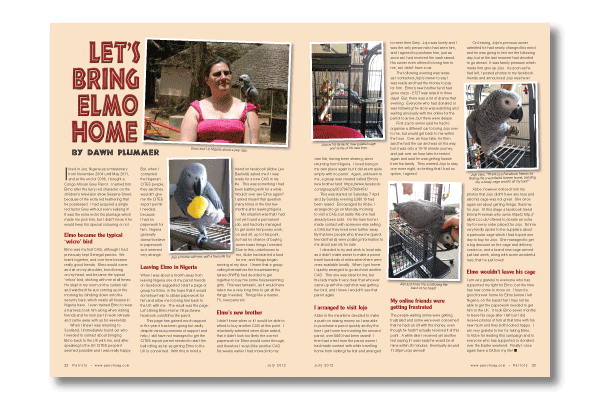
By Dawn Plummer
I lived in Jos, Nigeria as a missionary from November 2004 until May 2011, and at the end of 2006, I bought a Congo African Grey Parrot. I named him Elmo after the furry red character on the children’s television show Sesame Street, because of the extra red feathering that he possessed. I had acquired a single red factor Grey without even realising it! It was the extra red in his plumage which made me pick him, but I didn’t know if he would keep his special colouring or not.
Elmo became the typical ‘velcro’ bird
Elmo was my first CAG, although I had previously kept Senegal parrots. We learnt together, and over time became really good friends. Elmo would come and sit on my shoulder, loved being on my head, and became the typical ‘velcro’ bird, sticking with me at all times. He slept in my room on the curtain rail and watched the sun coming up in the morning by climbing down onto the security bars, which nearly all houses in Nigeria have. I even trained Elmo to wear a harness, took him along when visiting friends and he took part in work retreats and came away with us for weekends.
Read more in the magazine…





